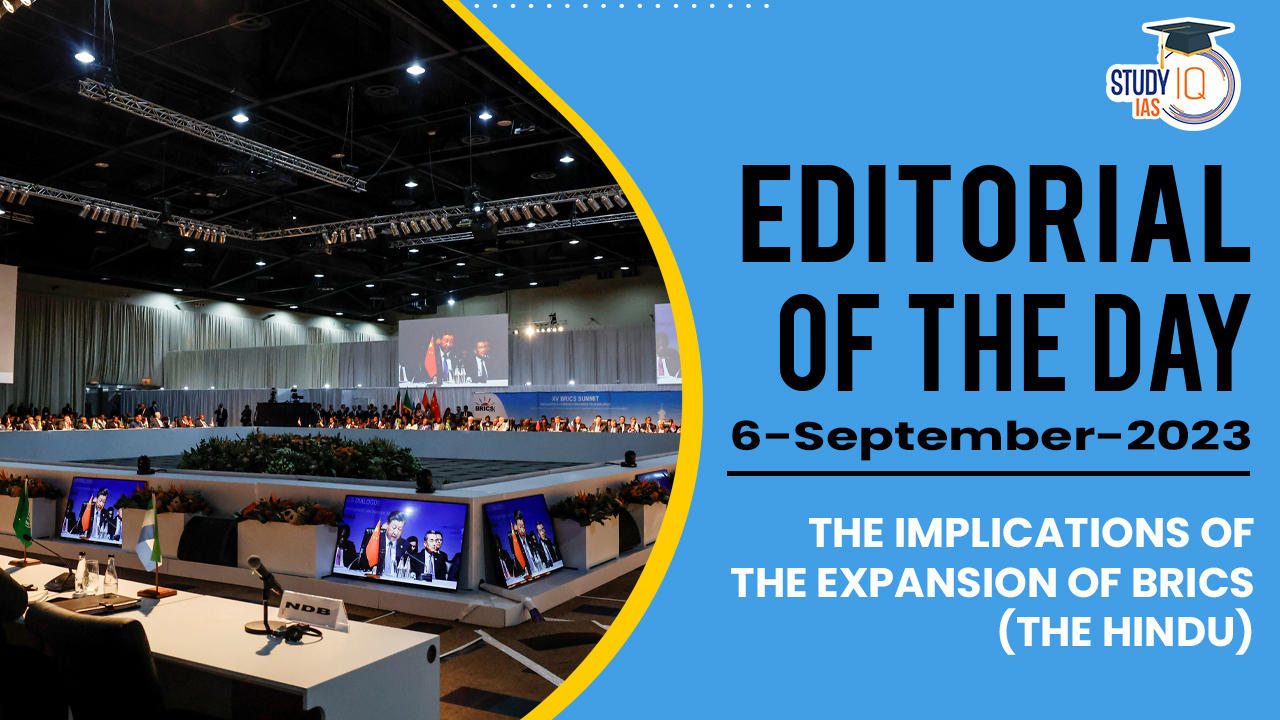Table of Contents
Context: The article is discussing the 15th BRICS summit, which took place in Johannesburg and included the five core BRICS members: Brazil, Russia, India, China, and South Africa. The article highlights the recent expansion of BRICS and emphasizes that this expansion of membership has created a grouping with a significant global presence, as it will collectively have a substantial share of the world’s population, GDP, exports, and imports. Overall, the article discusses BRICS’s efforts to challenge the Western-dominated international order, its expansion to include new member countries, and the potential impact of this expansion on global geopolitics and the energy sector.
Background
What is BRICS?
- Definition: BRICS is an acronym for the grouping of the world’s leading emerging economies, namely Brazil, Russia, India, China, and South Africa.
- Establishment: In 2001, the British Economist Jim O’Neill coined the term BRIC to describe the four emerging economies of Brazil, Russia, India, and China.
- The grouping was formalised during the first meeting of BRIC Foreign Ministers’ in 2006.
- South Africa was invited to join BRIC in December 2010, after which the group adopted the acronym BRICS.
- Share of BRICS: The BRICS brings together five of the largest developing countries of the world, representing 41% of the global population, 24% of the global GDP and 16% of the global trade.
- Chairmanship: The chairmanship of the forum is rotated annually among the members, in accordance with the acronym B-R-I-C-S.
- India was the chair for 2021.
Initiatives By BRICS:
- New Development Bank:
- During the Sixth BRICS Summit in Fortaleza (Brazil) in 2014, the leaders signed the Agreement establishing the New Development Bank (NDB – Shanghai, China).
- Contingent Reserve Arrangement:
- In 2014, the BRICS governments had signed a treaty on the setting up of the contingent reserve arrangement.
- The arrangement is aimed at forestalling short-term balance of payments pressures, providing mutual support and strengthening financial stability of the BRICS nations.
- BRICS Payment System:
- BRICS countries are trying to create a payment system as an alternative to the SWIFT payment system. This has taken on a new urgency as post Ukraine war, Russia has been frozen out of SWIFT.
- Launch of Remote Sensing Satellite:
- BRICS nations signed an agreement for cooperation in remote sensing satellite data sharing.
- A Remote Sensing constellation of satellites has been launched with 6 satellites including 2 from India, 2 from China, 1 from Russia, and 1 Brazil-China collaboration.
- The pact will guide the remote sensing sharing mechanism to better help the socioeconomic development of the BRICS countries and meet common challenges, such as climate change, disaster relief and environmental protection.
Decoding the Editorial
Expansion of Membership:
- During the recent BRICS summit, it was announced that BRICS had extended invitations to six new countries for potential membership namely Iran, Saudi Arabia, the United Arab Emirates (UAE), Egypt, Ethiopia, and Argentina.
- The article highlights that BRICS, as a grouping, has been dissatisfied with the dominance of Western-led international institutions such as the World Bank, the International Monetary Fund (IMF), the United Nations, and the World Trade Organization (WTO).
- BRICS aims to challenge this Western-dominated world order by promoting cooperation among its member countries, establishing institutions that are outside Western control (such as the New Development Bank), and advocating for reforms in these international organizations to better represent the interests of emerging economies.
- Additionally, the expansion will have a major impact on the energy sector, particularly in terms of global oil production, as the BRICS members will have a much larger share of global oil output.
An Addition of Geostrategic Value:
- Geo-Strategic Value: The article highlights the geo-strategic significance of the new BRICS members.
- 35% of Saudi oil production goes to China and India;
- Russia, already a major oil supplier to China and India, is now looking at Brazil as a market.
- Despite sanctions by the United States, Iran has increased oil production from a low of 400,000 barrels per day in the Trump period to 2.2 mbd in August this year, most of it going to China.
- Egypt and Ethiopia are an important presence in the strategically important Horn of Africa and the Red Sea, while Argentina is the second largest economy in Latin America.
- Criticism of BRICS: The article addresses criticism from Western commentators who have characterized BRICS as a “talk-shop” with no shared vision and few accomplishments.
- However, these criticisms are countered by pointing out that BRICS leaders have consistently issued consensual declarations over the years and have expanded their areas of cooperation and interest.
- Johannesburg Declaration: It calls for wide-ranging reforms in international organisations, and intra-BRICS cooperation and focuses on outreach to other developing countries.
- Shared Political Views: The Declaration is said to reflect shared political views among BRICS members on various global issues, including the importance of the United Nations, conflicts in West Asia (Syria, Yemen, Palestine, the Arab peace Initiative, and the Iran nuclear agreement), the conflict in Ukraine, and the issue of global terrorism.
Outlook for regional and global affairs
The article discusses the outlook for regional and global affairs in the context of the new BRICS members, particularly those from West Asia, and their impact on the existing political and economic framework.
- BRICS and New Members: The article suggests that the inclusion of new BRICS members, especially those from West Asia (Saudi Arabia, UAE, and Iran), is seen as a natural fit within the BRICS political and economic framework.
- Independent Foreign Policies: Saudi Arabia and the UAE, in particular, have been pursuing more independent foreign policy paths, moving away from what is referred to as the “U.S. yoke” (heavy influence or control by the United States). Saudi Arabia has engaged in dialogue and regional diplomacy, including ending the blockade on Qatar and engaging with Iran. The UAE is also seeking to expand its influence in various regions.
- China-Brokered Accord: The article notes that regional engagements led to a China-brokered accord between Saudi Arabia and Iran in March, indicating China’s role in facilitating regional diplomacy.
- Economic Cooperation: Iran’s entry into BRICS, along with its role in the energy sector, can open opportunities for enhanced regional economic cooperation. The article also mentions the potential for the revival of connectivity projects, particularly through the Chabahar port in Iran, which India is associated with.
- Rejection of Binary Divide: The article emphasizes that BRICS members, including India, reject the idea of a new global binary divide or a “new cold war.” Instead, they assert their desire for strategic autonomy within a multipolar world order. BRICS member countries want their voices to be heard and their interests respected on the global stage.
- Significance of Johannesburg Summit: The article concludes by highlighting the significance of the Johannesburg summit, describing it as a “turning point in modern history,” indicating that it holds importance in shaping the evolving global order.
Beyond the Editorial
Relevance of BRICS for India: BRICS holds several significant opportunities for India, which contribute to its foreign policy objectives and economic interests:
- Economic and trade opportunities: BRICS provides a platform for India to explore economic and trade opportunities within the member countries, particularly in key markets like China. Despite existing security tensions, China remains an important commercial partner for India. Intra-BRICS trade, although currently modest, offers prospects for growth and deeper engagement.
- Managing relations with China: BRICS and other groupings like the Shanghai Cooperation Organization (SCO) allow India and China to compartmentalise their strategic contest while maintaining cooperation in other areas. This provides a platform for dialogue and collaboration on shared interests, decoupling strategic tensions from other dimensions of their relationship.
- Multi-aligned foreign policy: Participation in BRICS helps India balance its growing partnerships with the West. By engaging with non-Western groupings like BRICS, India demonstrates its commitment to strategic autonomy and a multi-aligned foreign policy. This allows India to maintain its own interests while engaging with both Western and non-Western actors.
- Quest for international status: Membership in BRICS elevates India’s global profile and presents an opportunity to project itself as a truly international player. Being a part of BRICS provides India with a platform to engage with other major emerging economies and contribute to global decision-making processes. It enhances India’s visibility and influence on the international stage.


 SSC Stenographer 2024 Notification Out a...
SSC Stenographer 2024 Notification Out a...
 IB SA MTS Final Result 2024 Out at mha.g...
IB SA MTS Final Result 2024 Out at mha.g...
 Model Skill Loan Scheme, Eligibility, Re...
Model Skill Loan Scheme, Eligibility, Re...

















